Deck 24: Memories of Past Life: Fossils and Evolution
Question
Question
Question
Question
Question
Question
Question
Question
Question
Question
Question
Question
Question
Question
Question
Question
Question
Question
Question
Question
Question
Question
Question
Question
Question
Question
Question
Question
Question
Question

Unlock Deck
Sign up to unlock the cards in this deck!
Unlock Deck
Unlock Deck
1/30
Play
Full screen (f)
Deck 24: Memories of Past Life: Fossils and Evolution
1
A scientist who studies fossils is known as a(n)
A) archaeologist.
B) paleontologist.
C) mineralogist.
D) seismologist.
A) archaeologist.
B) paleontologist.
C) mineralogist.
D) seismologist.
B
2
Why is the preservation potential of an organism higher if it dies in an anoxic (oxygen-poor)environment?
A) The organism will die more quickly without oxygen.
B) Anoxic environments contain abundant amounts of amber.
C) The organism decays slowly in an anoxic environment.
D) Oxygen decreases the rate of permineralization.
A) The organism will die more quickly without oxygen.
B) Anoxic environments contain abundant amounts of amber.
C) The organism decays slowly in an anoxic environment.
D) Oxygen decreases the rate of permineralization.
C
3
Most of the species found as fossils represent ________.
A) direct ancestors of species alive on the Earth today
B) species alive on the Earth today in the location where the fossil was found
C) species alive on the Earth today that now live in other locations
D) extinct species that no longer survive anywhere
A) direct ancestors of species alive on the Earth today
B) species alive on the Earth today in the location where the fossil was found
C) species alive on the Earth today that now live in other locations
D) extinct species that no longer survive anywhere
D
4
If two animals are members of the same kingdom,how closely are they related in comparison to two animals that are members of the same genus?
A) Animals of the same kingdom are less closely related than those of the same genus.
B) Animals of the same kingdom are more closely related than those of the same genus.
C) There is no way to tell how closely related they are without more information.
D) Animals of the same kingdom are not related at all.
A) Animals of the same kingdom are less closely related than those of the same genus.
B) Animals of the same kingdom are more closely related than those of the same genus.
C) There is no way to tell how closely related they are without more information.
D) Animals of the same kingdom are not related at all.

Unlock Deck
Unlock for access to all 30 flashcards in this deck.
Unlock Deck
k this deck
5
Imagine that a layer of leaves is scattered along a forest floor; what must happen in order to preserve these leaves as fossils?
A) The leaves must be picked up by wind or animals and carried to a desert.
B) The leaves must be buried slowly so that the leaves can begin to rot.
C) The leaves must be buried rapidly in order to keep out oxygen.
D) The leaves will never be preserved,as they do not contain hard parts.
A) The leaves must be picked up by wind or animals and carried to a desert.
B) The leaves must be buried slowly so that the leaves can begin to rot.
C) The leaves must be buried rapidly in order to keep out oxygen.
D) The leaves will never be preserved,as they do not contain hard parts.

Unlock Deck
Unlock for access to all 30 flashcards in this deck.
Unlock Deck
k this deck
6
What type of fossil,examples of which are shown in the figure,is composed of remnants of plankton,algae,bacteria,and pollen? 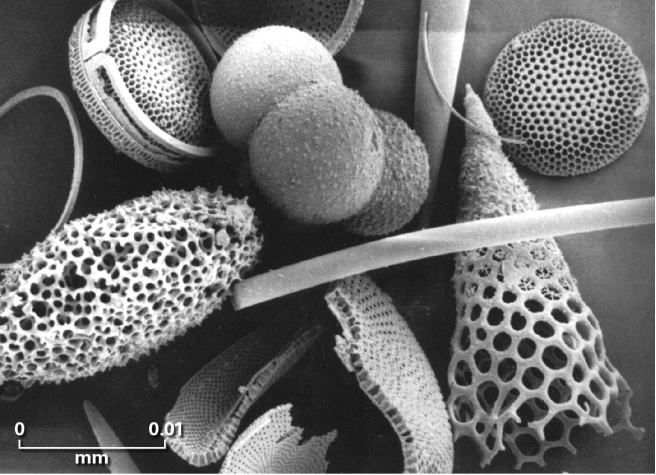
A) microfossil
B) chemical fossil
C) trace fossil
D) body fossil

A) microfossil
B) chemical fossil
C) trace fossil
D) body fossil

Unlock Deck
Unlock for access to all 30 flashcards in this deck.
Unlock Deck
k this deck
7
Which of the following is a brachiopod? 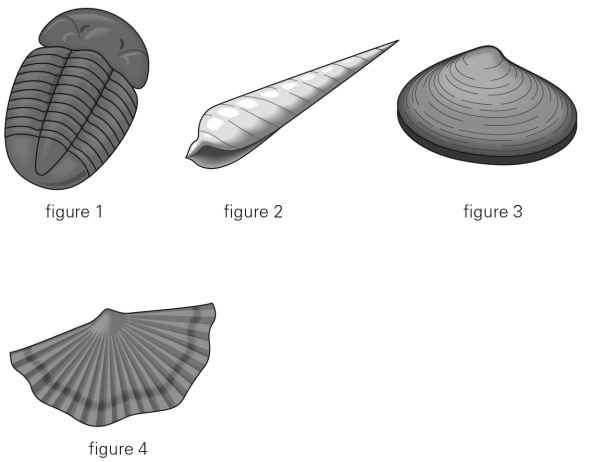
A) Figure 1
B) Figure 2
C) Figure 3
D) Figure 4

A) Figure 1
B) Figure 2
C) Figure 3
D) Figure 4

Unlock Deck
Unlock for access to all 30 flashcards in this deck.
Unlock Deck
k this deck
8
Fossils are most often identified based on changes in their ________,which is easily recognizable,even in the field.
A) morphology
B) DNA
C) domain
D) lifestyle
A) morphology
B) DNA
C) domain
D) lifestyle

Unlock Deck
Unlock for access to all 30 flashcards in this deck.
Unlock Deck
k this deck
9
Impressions that organisms leave behind in soft sediment,such as footprint and burrows,can become what type of fossil?
A) skeletal fossils
B) trace fossils
C) molecular fossils
D) permineralized fossils
A) skeletal fossils
B) trace fossils
C) molecular fossils
D) permineralized fossils

Unlock Deck
Unlock for access to all 30 flashcards in this deck.
Unlock Deck
k this deck
10
In which of the following rocks would you be most likely to find fossils?
A) gneiss
B) limestone
C) granite
D) basalt
A) gneiss
B) limestone
C) granite
D) basalt

Unlock Deck
Unlock for access to all 30 flashcards in this deck.
Unlock Deck
k this deck
11
What is the term for the yellow to orange clear stone that forms from sticky plant resins,often containing body fossils of trapped insects? 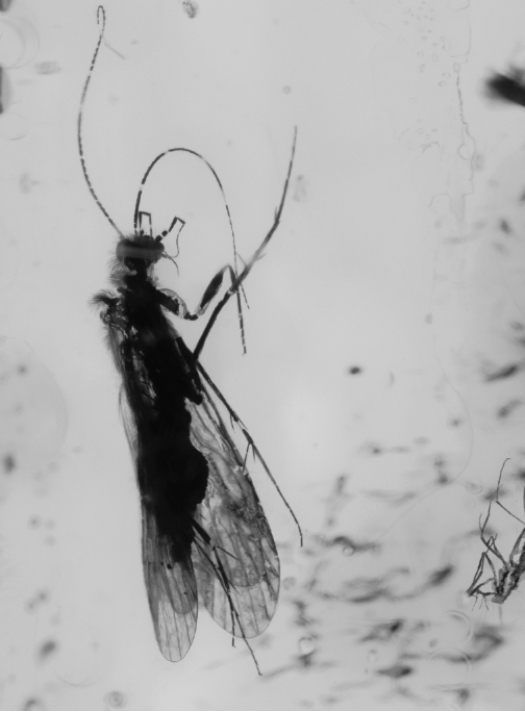
A) cast and mold
B) biomarker
C) amber
D) trace fossils

A) cast and mold
B) biomarker
C) amber
D) trace fossils

Unlock Deck
Unlock for access to all 30 flashcards in this deck.
Unlock Deck
k this deck
12
What type of fossil forms when a shell pushes in soft sediment,leaving an impression that gets incorporated into the rock even if the shell itself dissolves away?
A) body fossil
B) trace fossil
C) mold fossil
D) chemical fossil
A) body fossil
B) trace fossil
C) mold fossil
D) chemical fossil

Unlock Deck
Unlock for access to all 30 flashcards in this deck.
Unlock Deck
k this deck
13
Which of the following circumstances is most likely to preserve a fossil?
A) Leaves from an ancient oak tree fall to the ground in a forest.
B) A mammoth dies of starvation in the middle of a vast dry plain.
C) An oyster bed is buried by a submarine landslide.
D) Bacteria living in the ocean die near the shoreline and sink to the bottom.
A) Leaves from an ancient oak tree fall to the ground in a forest.
B) A mammoth dies of starvation in the middle of a vast dry plain.
C) An oyster bed is buried by a submarine landslide.
D) Bacteria living in the ocean die near the shoreline and sink to the bottom.

Unlock Deck
Unlock for access to all 30 flashcards in this deck.
Unlock Deck
k this deck
14
What type of fossil is shown in the picture? 
A) body fossil
B) trace fossil
C) permineralized fossil
D) cast fossil

A) body fossil
B) trace fossil
C) permineralized fossil
D) cast fossil

Unlock Deck
Unlock for access to all 30 flashcards in this deck.
Unlock Deck
k this deck
15
Why was the Cambrian Explosion an important event in the evolution of life on the Earth?
A) This is when life first appeared on the Earth.
B) This is when multicellular life forms evolved.
C) This is when a great variety of invertebrates with shells appear in the fossil record.
D) This is when plants and land animals first occurred.
A) This is when life first appeared on the Earth.
B) This is when multicellular life forms evolved.
C) This is when a great variety of invertebrates with shells appear in the fossil record.
D) This is when plants and land animals first occurred.

Unlock Deck
Unlock for access to all 30 flashcards in this deck.
Unlock Deck
k this deck
16
Why do plant fossils typically occur as carbonized impressions between layers in rocks?
A) because chemical reactions leave behind only the carbon
B) because they often begin to decay before fossilization
C) because they are easily moved by winds and water
D) because they are generally scavenged by animals
A) because chemical reactions leave behind only the carbon
B) because they often begin to decay before fossilization
C) because they are easily moved by winds and water
D) because they are generally scavenged by animals

Unlock Deck
Unlock for access to all 30 flashcards in this deck.
Unlock Deck
k this deck
17
Biomarkers,or compounds preserved in rocks that derive from particular organisms,are a type of:
A) permineralized fossil.
B) chemical fossil.
C) trace fossil.
D) body fossil preserved in tar.
A) permineralized fossil.
B) chemical fossil.
C) trace fossil.
D) body fossil preserved in tar.

Unlock Deck
Unlock for access to all 30 flashcards in this deck.
Unlock Deck
k this deck
18
Which major kingdom would a bivalve belong to?
A) Protista
B) Animalia
C) Plantae
D) Fungi
A) Protista
B) Animalia
C) Plantae
D) Fungi

Unlock Deck
Unlock for access to all 30 flashcards in this deck.
Unlock Deck
k this deck
19
Which of the following components of animals' bodies are most likely to form fossils?
A) internal soft tissue
B) bones,teeth and shells
C) external soft tissues such as skin,feathers,and fur
D) internal organs
A) internal soft tissue
B) bones,teeth and shells
C) external soft tissues such as skin,feathers,and fur
D) internal organs

Unlock Deck
Unlock for access to all 30 flashcards in this deck.
Unlock Deck
k this deck
20
Petrified wood,such as shown in the figure below,is an example of what type of fossil? 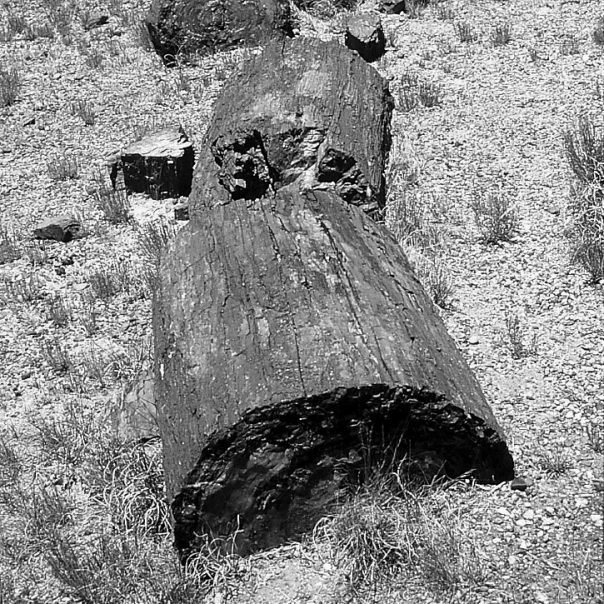
A) trace fossil
B) permineralized fossil
C) carbonized impression
D) mold or cast fossil

A) trace fossil
B) permineralized fossil
C) carbonized impression
D) mold or cast fossil

Unlock Deck
Unlock for access to all 30 flashcards in this deck.
Unlock Deck
k this deck
21
How is a mass extinction event different from extinction?

Unlock Deck
Unlock for access to all 30 flashcards in this deck.
Unlock Deck
k this deck
22
What is the term for the several times in the Earth's history when biodiversity (i.e.,number of genera)has rapidly decreased worldwide? 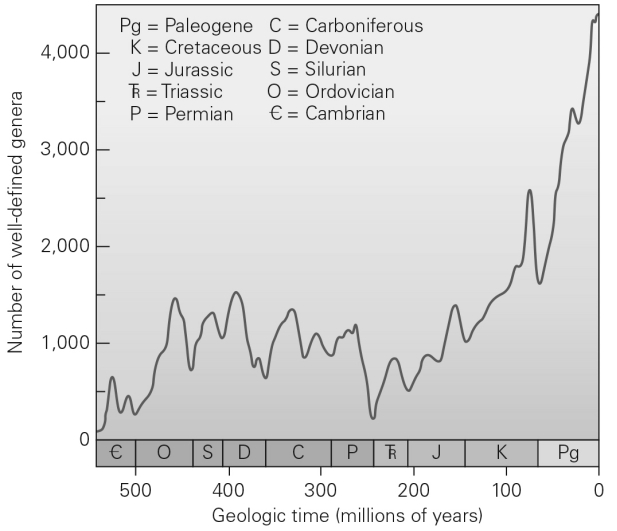
A) punctuated equilibrium
B) evolution
C) mass extinction
D) speciation

A) punctuated equilibrium
B) evolution
C) mass extinction
D) speciation

Unlock Deck
Unlock for access to all 30 flashcards in this deck.
Unlock Deck
k this deck
23
What is a fossil? In what type(s)of rock are fossils most likely to be found? What factors influence an organism's preservation potential to form a fossil?

Unlock Deck
Unlock for access to all 30 flashcards in this deck.
Unlock Deck
k this deck
24
Global climate change,tectonic activity,asteroid impacts,and large volcanic eruptions are all factors that have led to ________ in the fossil record.
A) extinction of species
B) fossilization of soft tissues
C) reappearance of extinct species
D) lack of changes in biodiversity
A) extinction of species
B) fossilization of soft tissues
C) reappearance of extinct species
D) lack of changes in biodiversity

Unlock Deck
Unlock for access to all 30 flashcards in this deck.
Unlock Deck
k this deck
25
Label each fossil in the image below with the common fossil name. 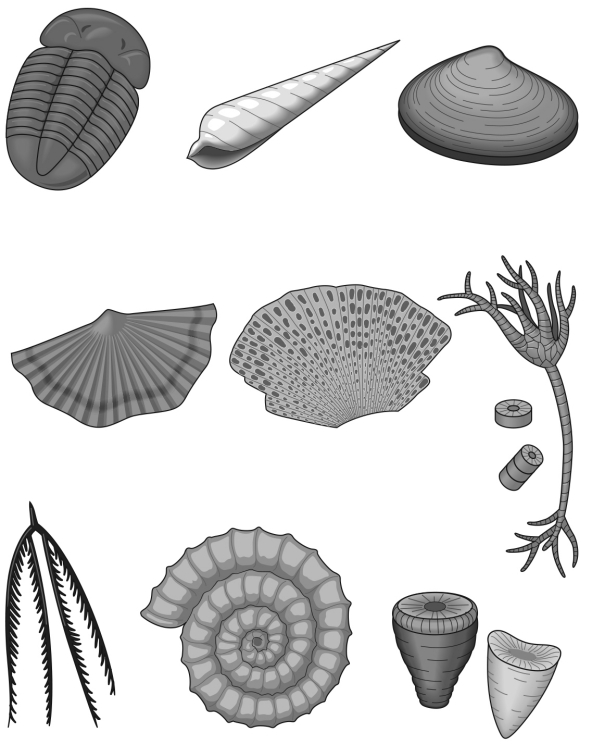


Unlock Deck
Unlock for access to all 30 flashcards in this deck.
Unlock Deck
k this deck
26
Explain why the fossil record is incomplete.

Unlock Deck
Unlock for access to all 30 flashcards in this deck.
Unlock Deck
k this deck
27
Which of the following is an example of natural selection?
A) birds that evolve a new beak shape in order to exploit a different food source
B) the extinction of the mammoths due to hunting by a new predator
C) fossils of trilobites that have the same morphology but are separated by millions of years
D) the mass extinction of the dinosaurs due to a meteorite's impact 65 million years ago
A) birds that evolve a new beak shape in order to exploit a different food source
B) the extinction of the mammoths due to hunting by a new predator
C) fossils of trilobites that have the same morphology but are separated by millions of years
D) the mass extinction of the dinosaurs due to a meteorite's impact 65 million years ago

Unlock Deck
Unlock for access to all 30 flashcards in this deck.
Unlock Deck
k this deck
28
What is natural selection?
A) the theory that all life began in shallow coastal pools of protein-rich water
B) the theory that all life on the Earth has evolved from single-celled organisms
C) the idea that animals who share specialized characteristics are part of a genus
D) the passing on of beneficial characteristics so that the most adaptable survive
A) the theory that all life began in shallow coastal pools of protein-rich water
B) the theory that all life on the Earth has evolved from single-celled organisms
C) the idea that animals who share specialized characteristics are part of a genus
D) the passing on of beneficial characteristics so that the most adaptable survive

Unlock Deck
Unlock for access to all 30 flashcards in this deck.
Unlock Deck
k this deck
29
Study of the fossil record has revealed that species go extinct and new species evolve
A) very slowly most of the time,with short periods of rapid evolution.
B) at roughly the same rates for all of life's history.
C) only during times of continental rifting.
D) at the same rates for all types of organisms.
A) very slowly most of the time,with short periods of rapid evolution.
B) at roughly the same rates for all of life's history.
C) only during times of continental rifting.
D) at the same rates for all types of organisms.

Unlock Deck
Unlock for access to all 30 flashcards in this deck.
Unlock Deck
k this deck
30
Why are fossils almost exclusively found in sedimentary rocks?

Unlock Deck
Unlock for access to all 30 flashcards in this deck.
Unlock Deck
k this deck



